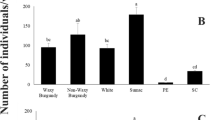Abstract
Sweet sorghum (Sorghum bicolor (L.) Moench) was introduced recently into Greece and is being cultivated experimentally for the production of liquid biofuel. A pilot survey was conducted in October 2005 to provide information on the species composition and density of its lepidopterous stem borers, which appear to cause severe losses in production. The dominant pest in that season wasSesamia nonagrioides Lefebvre, with a mean density of 1.41 larvae per plant. Larvae were sampled from various plant internodes and found to have a preference for the lower ones. Analysis of variance showed no significant effects on larval density of the irrigation levels or of the organic — conventional soil fertilization method. A significant negative correlation was found between the body length ofS. nonagrioides larvae and the internode from which they were retrieved. This is the first published report of sorghum borer pests in Greece.
Similar content being viewed by others
References
Badolato, R. (1976) Caracteres comparativos entreSesamia nonagrioides (Lef., 1827) yS. cretica (Led., 1857) en sus distintas fases de desarrollo.Graellsia 32:265–277 (Spanish, with English summary).
Gillyboeuf, N., Anglade, P., Lavenseau, L. and Peypelut, L. (1994) Cold hardiness and overwintering strategy of the pink maize stalk borer,Sesamia nonagrioides Lef. (Leipidoptera, Noctuidae).Oecologia 99:366–373.
Isaac, P.V. and Rao, K.V. (1941) A key for the identification of the larvae of the known lepidopterous borers of sugarcane in India, based on morphological characters.Indian J. Agric. Sci. 11:795–803.
Nepveu, P. (1953) Observations sur la morphologie et la biologie des Sesamies du mais et du sorgho en France (Sesamia nonagrioides Lef. etS. cretica Led.).Ann. Epiphyt. 4:445–457.
Nye, I.W.B. (1960) The insect pests of graminaceous crops in East Africa.Colon. Res. Stud. No. 31:1–48. H.M.S.O., London, UK.
Prota, R. (1965) Osservazioni sull’ etologia diSesamia nonagrioides (Lefebvre) in Sardegna.Studi Sass. Ann. Fac. Agr. Sassari 13:336–360 (Italian, with English summary).
SPSS (1999) User’s Manual. SPSS Inc., Chicago, IL, USA.
Stavrakis, G.N. (1967) Contributions à l’étude des espéces nuisibles au mais en Grece du genreSesamia (Lepidoptères-Noctuidae).Annls. Inst. Phytopathol. Benaki 8:20–23.
Tams, W.H.T. and Bowden, J. (1953) A revision of the African species ofSesamia Guenée and related genera (Agrotidae — Lepidoptera).Bull. Entomol. Res. 43:645–678.
Tsitsipis, J.A., Gliatis, A. and Mazomenos, B.E. (1984) Seasonal appearance of the corn stalk borer,Sesamia nonagrioides, in Central Greece.Meded. Fac. Landbouwwet. Rijksuniv. Gent 49:667–674.
Tsitsipis, J.A., Mazomenos, B.E., Christoulas, C., Mouloudis, S., Stefanakis, M., Papageorgiou, G.et al. (1983) Report on the lepidopterous insects attacking corn in Greece with emphasis on the corn stalk borer,Sesamia nonagrioides. 9 th Interbalkanic Plant Protection Conf. (Athens, Greece).
Author information
Authors and Affiliations
Corresponding author
Additional information
http://www.phytoparasitica.org posting Feb. 7, 2007.
Rights and permissions
About this article
Cite this article
Dimou, I., Pitta, E. & Angelopoulos, K. Note: Corn stalk borer (Sesamia nonagrioides) infestation on sorghum in central Greece. Phytoparasitica 35, 191–193 (2007). https://doi.org/10.1007/BF02981113
Received:
Accepted:
Issue Date:
DOI: https://doi.org/10.1007/BF02981113




